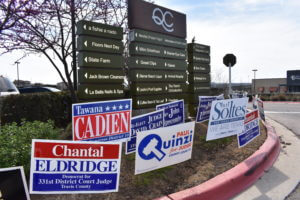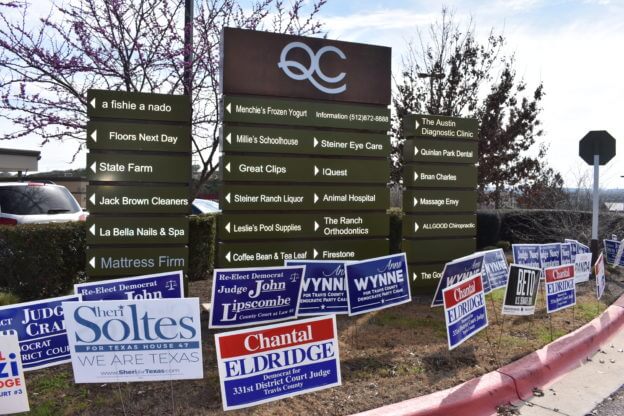Rules on election signs in Four Points

Campaign signs remained at Quinlan Crossing shopping center last week, two days following the state’s primary election. LESLEE BASSMAN
By LESLEE BASSMAN, Four Points News
With the March 6 primary election over but the upcoming May 5 election campaign in full swing, Four Points’ lawns and thoroughfares are dotted with candidate signs.
According to the Texas Department of Transportation, “during campaign season, the landscape blooms with a special kind of flower—the political sign. Unlike wildflowers that are welcome anywhere, putting campaign signs on public lands is illegal.”
So, what rights do local homeowners and communities have with regard to election signage?
The rules and regulations governing these types of signs are complex in western Travis County, a region that includes the city of Austin proper, such as River Place; the jurisdiction surrounding the city but without voting rights or a tax requirement, such as Steiner Ranch; and other unincorporated sections.
Sign wars
“Disputes over political signs are often referred to as ‘sign wars,’” Travis County Clerk Dana DeBeauvoir said. “If you feel like you’ve been inundated with signs, you are not alone.”
TxDOT regulates signs along the state’s highways pursuant to the Highway Beautification Act as well as highways and roads in unincorporated areas of Travis County, under the State Rural Roads Act.
TxDOT, on its website, cautions residents to know their rights before “planting” a sign because it is illegal to place any signs on or within a public right of way, including signs on telephone poles or trees that are located in a right of way.
“TxDOT can pick up those signs anytime and throw them away, including more than political signs, even a garage sale sign,” DeBeauvoir said of signs in rights of way or easements.
Campaign signs along a Texas road can be put on private property with the owner’s permission, the website states. City ordinances apply if the sign site selected is within a city’s limits, such as Austin.
However, the city of Austin does not have a specific code or ordinance covering electoral signs, City of Austin Code Supervisor Michael Reeves said.
“We have ordinances that state electoral signs are not allowed to be posted in the right of way or on utility poles, light poles, things like that,” he said. “If [the sign] is in the right of way, it’s a violation.”
Rights of way—areas prohibited from containing signage—include medians, intersection corners, traffic islands as well as areas between the street and the sidewalk; the street and utility poles; the street and the first expansion joint in a driveway, according to Austin City Code.
Residents can place large electoral signs on private property, Reeves said. The city has enforcement rights for signage within its extraterritorial jurisdiction, or ETJ, meaning an area adjacent to its borders such as Steiner Ranch, he said.
Homeowners associations
Local Four Points communities—including River Place, Steiner Ranch and The Parke at Grandview Hills—are governed by homeowners associations. Although these groups may have more restrictive covenants pertaining to signage than the city or county, state property code laws prevent an HOA from prohibiting political signage on its residents’ lawns.
“It does matter where you live (when it comes to signage),” DeBeauvoir said. “An HOA can set rules and tell (residents) what they can do with their property while living there.”
For instance, a River Place Homeowners Association regulation “limits a property owner to displaying only one sign for each candidate or ballot item” and signage cannot be larger than four feet by six feet in size. These signs must also be ground mounted pursuant to the HOA rules.
The HOA covenants governing The Parke at Grandview Hills sections 1-3 specifically allows “signs advocating the support of political candidates or issues erected prior to the election to which they pertain” but does not contain further restrictions on the size of a political sign other than general sign restrictions within the community.
On the residential side, the Steiner Ranch Community Associations follow Texas Property Code ordinances, Architectural and Community Standards coordinator Robin Kasper said.
“We can ask that residents locate the signs close to the home and if possible in a flower bed so that homes with signs look more uniform,” Kasper said.
Post-election
There are no relevant code restrictions on sign removal, DeBeauvoir said.
“The rule of thumb is (a sign owner) has 10 days to pick up the sign,” she said. “There’s been talk about trying to pass a rule about it but it’s one of those good conduct, good manners sorts of things.
Reeves said HOAs can enforce their own restrictive covenants pertaining to signage removal but “when it comes to (city of Austin) enforcing, we have to stick strictly to the code itself.”
He said there is a practical aspect to removing signs after an election.
“If a complaint comes in about a sign (lingering), I don’t believe those signs will stay because the code inspector will remove the signs,” Reeves said. “When I was an inspector, I would normally allow 30 days afterwards (to remove the signs) as long as it wasn’t a danger. If they didn’t, I then went through my district and removed them myself.”
He said code enforcement must respond to complaints within five days but the issue of signage is not a high priority.
“The way our response and priorities for (code) violations are prioritized, signs are about the lowest priority that we have, unless they create a traffic or pedestrian hazard,” Reeves said. “And that would bump them up to a higher priority to take care of.”
Penalties for sign violations can vary, depending on the judge or prosecutor setting the fine amount but fees “could be $50 on up to $200 per sign,” he said.
“When it gets down to setting the fines and the fees, electoral signs may not be as hard to identify who put them up or who they are tied to,” Reeves said. “But a lot of the other signs—’we buy houses’ and things like that—the difficulty we have is actually determining who owns the sign.”
Once a sign owner has been notified of a violation, he or she has 14 days to comply or remove the sign from the time the notice is received, he said.
Homeowners associations, by state law, can regulate the amount of time an election sign can be posted within the community.
Political signs in River Place and Steiner Ranch, pursuant to the neighborhoods’ regulations, can be erected within 90 days before the election but must be removed within 10 days after the election.
TxDOT, on its website, states that it will remove a sign on a property if it is posing a traffic hazard, with the costs associated with the sign removal to be paid by the sign’s owner.
The city of Austin recycles campaign signs for free through Austin Resource Recovery. For more information on this program, see http://www.austintexas.gov/department/austin-resource-recovery.


